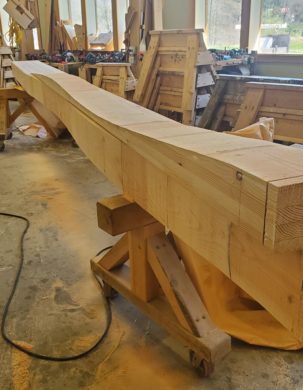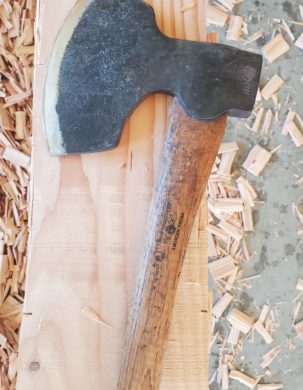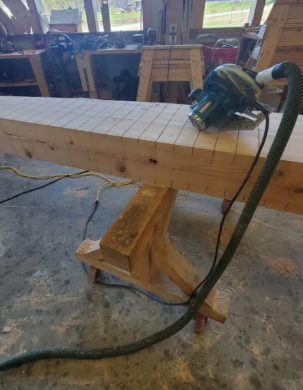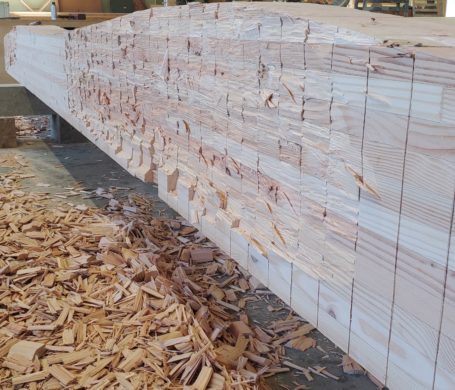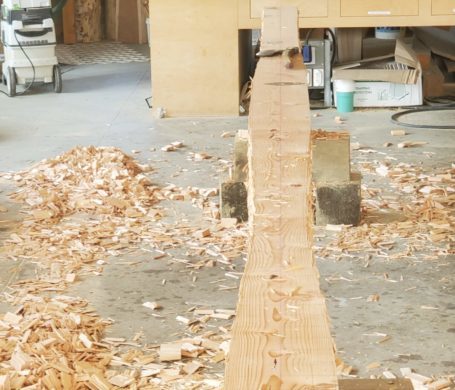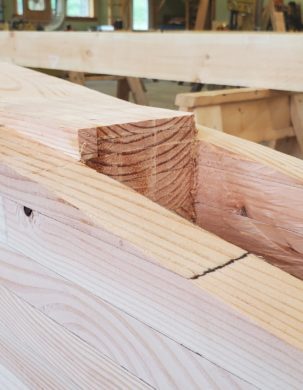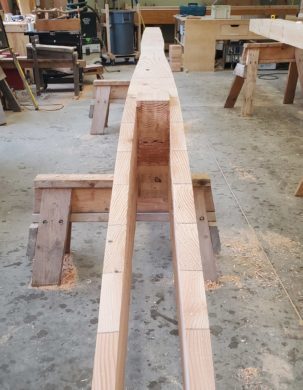Isn’t it nice to be the person someone calls when they need a hard job done right? Last spring, the folks at TimberHomes Vermont took on a project of a very curvy nature for Auburndale builders, one which proved to be quite challenging and required just about every tool in the shop.
The project was, in brief, a 24′ long glue-laminate douglass fir beam that curves gently over its length on three of its four sides. It will find its home as a structural support and aesthetic accent in a custom kitchen in the Boston area. TimberHomes took on this task under the impression that all three faces of the beam could be cut with the company’s handheld bandsaw, which can cut to a depth of 12″ through an 8″ wide throat. However, upon arrival it was discovered that the wide dimension of the beam was just over 18″, making it far too wide to be cut with any of the shop’s saws. Many TimberGnomes weighed in on how to proceed, and through some creative problem solving and collaborative thinking a solution was devised.
1. Lay out a curved line on flat top face of the beam, as well as a “fat” layout line to leave room for finishing
2. Cut to “fat” depth every three inches along the beam with handheld circular saw
3. Hand hew the beam down to those saw kerfs
4. Smooth out beam curvature with virutex concave power planer until kerf lines just disappear.
5. sand to 40 grit to iron out marks left by planer
If you just read that and are asking yourself, “did she just say that this modern engineered timber was HAND HEWN!?” you’re not going crazy. That’s right, the only practical solution to shaping this beam involved using an antique hewing axe to shape this very modern piece of wood. Old meets new at its finest.
It took two really solid days of hewing to carve this beam down to the point that it was ready for the planer, and it was a workout to say the least. Given that this wood was kiln dried, the hewing process created large splintery chips instead of soft shavings, and tear out became a concern as the beam approached its planing dimension.
Once hewn, the beam was really beginning to resemble its final shape, though many passers by were concerned at the gnarled appearance of this timber-in-progress. But with about a day of power planing, the once-splintered surface was rendered into a smooth, gently undulating curve. A pass with the disc sander smoothed out sharp edges left by the planer, and the general shaping of the beam was complete.
Almost complete at this point, one challenging detail remained. The plans sent by Auburndale Builders called for a fork to be cut into about 5′ on one end, a cut which, like the curves in the piece at large, could not be made with any one power tool. But with some creative planning and careful use of the right tools in the right order, the fork was cut in only a few hours. For this detail alone, the portable bandsaw, beam saw, chainsaw, chain mortiser, wood owl, and hand saw were all called into action. Once the fork was cut, the beam was done!
The following week, the beam was delivered to its home in Somerville, presented with pride to the builders who are incorporating it into what has got to be an absolutely stunning kitchen. Dawn, who did the majority of the work on this project, welcomed the chance to do something so purely sculptural, and would welcome similar projects like this in the future, even if they are challenging and labor intensive.
